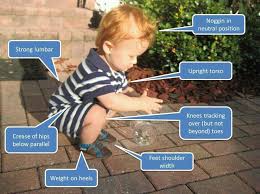There was a blog post recently that has sparked some heated debate over the past five days since it was posted. The original blog post was trying to point out that certain types of hip and femur structures will affect the squat position of each client, basically concluding that each person will feel comfortable in one foot position may not be the same as another. Apparently, his post got around to a bunch of people, including a DC Area Crossfit Coach who had nothing nice to say about poster (including saying "When you come at the king, you best not miss" a quote from the show The Wire). The original poster responded with a short video explaining that he was not trying to disprove mobility training, but was instead trying to enlighten trainers to some potential structural differences that may affect their client's ability to go.... ahem.... where they have never gone before.

I can tell you that studies have been conducted and written about in expert textbooks. One such book is "Strength Training Anatomy" 3rd Edition. For example, on p. 127 the author discusses how femur length changes the tilt of the torso during the squat, as does ankle flexibility. He also points out how femur length can affect the position of the pelvis when going below horizontal on the squat.
The author further develops the issues involved in squating and deadifting in a separate section on p. 130 titled "Adapting Training to your Morphology." He further expands on torso tilt, which muscles are active in each type of body structure, and how flexibility affects the body's cantilever.
Take all of that into account, and you have yourself a pretty complicated exercise. The position of the bar, the torso, the pelvis and the angle of the thigh and lower leg (in relation to the ankle) are all part of what makes a good squat. Being aware of the differences in bone structure is just as important as monitoring a client's mobility.
And since a squat is a basic functional movement- it benefits everyone to be aware of every angle and every detail to perform it safely and effectively.
I can tell you that studies have been conducted and written about in expert textbooks. One such book is "Strength Training Anatomy" 3rd Edition. For example, on p. 127 the author discusses how femur length changes the tilt of the torso during the squat, as does ankle flexibility. He also points out how femur length can affect the position of the pelvis when going below horizontal on the squat.
The author further develops the issues involved in squating and deadifting in a separate section on p. 130 titled "Adapting Training to your Morphology." He further expands on torso tilt, which muscles are active in each type of body structure, and how flexibility affects the body's cantilever.
Take all of that into account, and you have yourself a pretty complicated exercise. The position of the bar, the torso, the pelvis and the angle of the thigh and lower leg (in relation to the ankle) are all part of what makes a good squat. Being aware of the differences in bone structure is just as important as monitoring a client's mobility.
And since a squat is a basic functional movement- it benefits everyone to be aware of every angle and every detail to perform it safely and effectively.
Comments
Post a Comment